FINA200 Fall 2018: Personal Finance, Investment & Retirement Case
VerifiedAdded on 2023/05/30
|9
|2459
|411
Case Study
AI Summary
This FINA200 Personal Finance case study from Fall 2018 explores various financial planning scenarios. It includes multiple-choice questions and mini-cases covering topics such as the Home Buyer’s Plan (HBP), mutual fund investments, Management Expense Ratios (MER), Term to 100 insurance, and credit scores. The mini-cases delve into TFSA contributions, capital gains calculations, OAS claw-backs, estate planning issues, and mortgage calculations including down payments, loan-to-value ratios, and mortgage default insurance. The solutions provide detailed calculations and explanations for each scenario, offering insights into investment decisions, tax implications, and retirement planning strategies. The document also includes relevant tax tables and time value of money formulas to aid in problem-solving. This assignment is available on Desklib, where students can find more solved assignments and past papers.
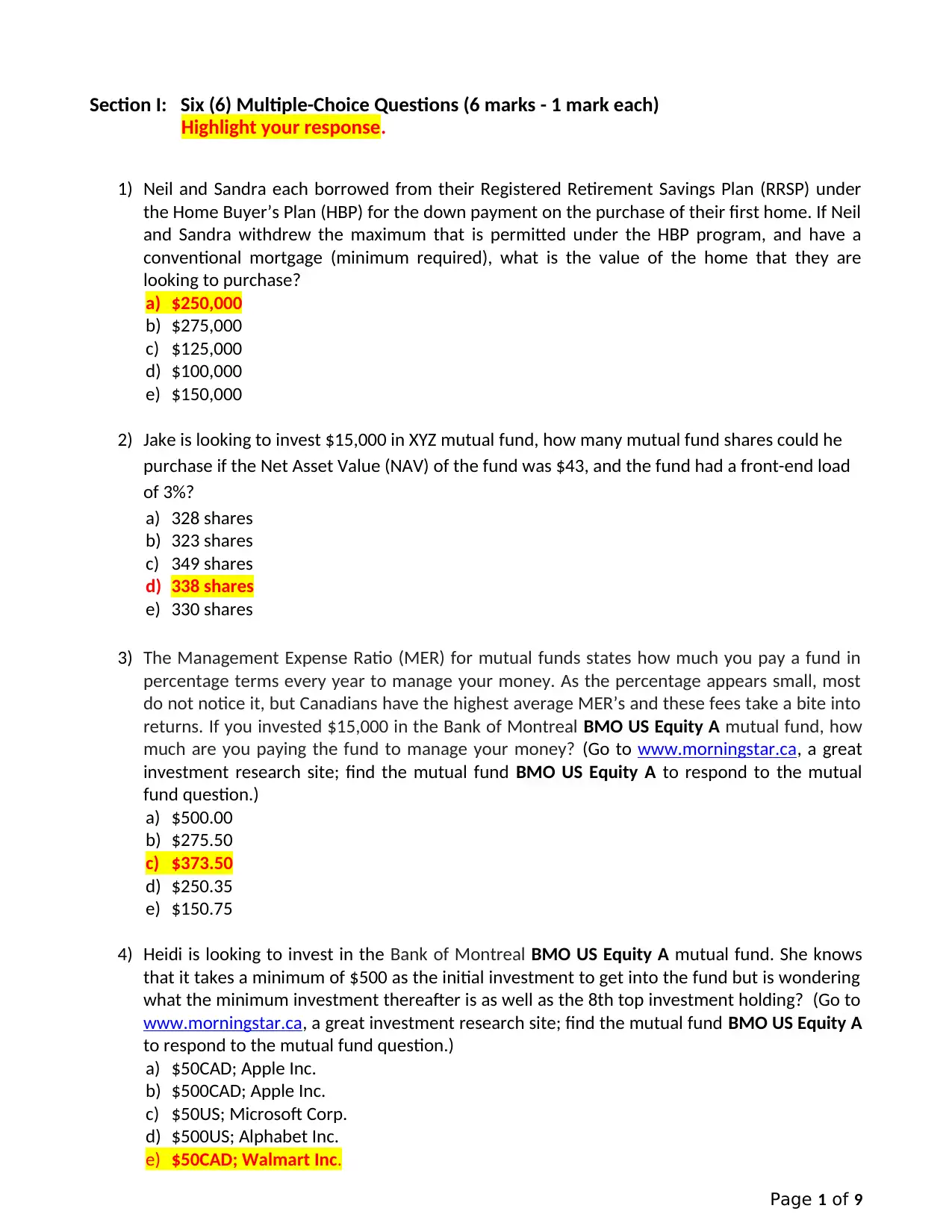
Page 1 of 9
Section I: Six (6) Multiple-Choice Questions (6 marks - 1 mark each)
Highlight your response.
1) Neil and Sandra each borrowed from their Registered Retirement Savings Plan (RRSP) under
the Home Buyer’s Plan (HBP) for the down payment on the purchase of their first home. If Neil
and Sandra withdrew the maximum that is permitted under the HBP program, and have a
conventional mortgage (minimum required), what is the value of the home that they are
looking to purchase?
a) $250,000
b) $275,000
c) $125,000
d) $100,000
e) $150,000
2) Jake is looking to invest $15,000 in XYZ mutual fund, how many mutual fund shares could he
purchase if the Net Asset Value (NAV) of the fund was $43, and the fund had a front-end load
of 3%?
a) 328 shares
b) 323 shares
c) 349 shares
d) 338 shares
e) 330 shares
3) The Management Expense Ratio (MER) for mutual funds states how much you pay a fund in
percentage terms every year to manage your money. As the percentage appears small, most
do not notice it, but Canadians have the highest average MER’s and these fees take a bite into
returns. If you invested $15,000 in the Bank of Montreal BMO US Equity A mutual fund, how
much are you paying the fund to manage your money? (Go to www.morningstar.ca, a great
investment research site; find the mutual fund BMO US Equity A to respond to the mutual
fund question.)
a) $500.00
b) $275.50
c) $373.50
d) $250.35
e) $150.75
4) Heidi is looking to invest in the Bank of Montreal BMO US Equity A mutual fund. She knows
that it takes a minimum of $500 as the initial investment to get into the fund but is wondering
what the minimum investment thereafter is as well as the 8th top investment holding? (Go to
www.morningstar.ca, a great investment research site; find the mutual fund BMO US Equity A
to respond to the mutual fund question.)
a) $50CAD; Apple Inc.
b) $500CAD; Apple Inc.
c) $50US; Microsoft Corp.
d) $500US; Alphabet Inc.
e) $50CAD; Walmart Inc.
Section I: Six (6) Multiple-Choice Questions (6 marks - 1 mark each)
Highlight your response.
1) Neil and Sandra each borrowed from their Registered Retirement Savings Plan (RRSP) under
the Home Buyer’s Plan (HBP) for the down payment on the purchase of their first home. If Neil
and Sandra withdrew the maximum that is permitted under the HBP program, and have a
conventional mortgage (minimum required), what is the value of the home that they are
looking to purchase?
a) $250,000
b) $275,000
c) $125,000
d) $100,000
e) $150,000
2) Jake is looking to invest $15,000 in XYZ mutual fund, how many mutual fund shares could he
purchase if the Net Asset Value (NAV) of the fund was $43, and the fund had a front-end load
of 3%?
a) 328 shares
b) 323 shares
c) 349 shares
d) 338 shares
e) 330 shares
3) The Management Expense Ratio (MER) for mutual funds states how much you pay a fund in
percentage terms every year to manage your money. As the percentage appears small, most
do not notice it, but Canadians have the highest average MER’s and these fees take a bite into
returns. If you invested $15,000 in the Bank of Montreal BMO US Equity A mutual fund, how
much are you paying the fund to manage your money? (Go to www.morningstar.ca, a great
investment research site; find the mutual fund BMO US Equity A to respond to the mutual
fund question.)
a) $500.00
b) $275.50
c) $373.50
d) $250.35
e) $150.75
4) Heidi is looking to invest in the Bank of Montreal BMO US Equity A mutual fund. She knows
that it takes a minimum of $500 as the initial investment to get into the fund but is wondering
what the minimum investment thereafter is as well as the 8th top investment holding? (Go to
www.morningstar.ca, a great investment research site; find the mutual fund BMO US Equity A
to respond to the mutual fund question.)
a) $50CAD; Apple Inc.
b) $500CAD; Apple Inc.
c) $50US; Microsoft Corp.
d) $500US; Alphabet Inc.
e) $50CAD; Walmart Inc.
Paraphrase This Document
Need a fresh take? Get an instant paraphrase of this document with our AI Paraphraser
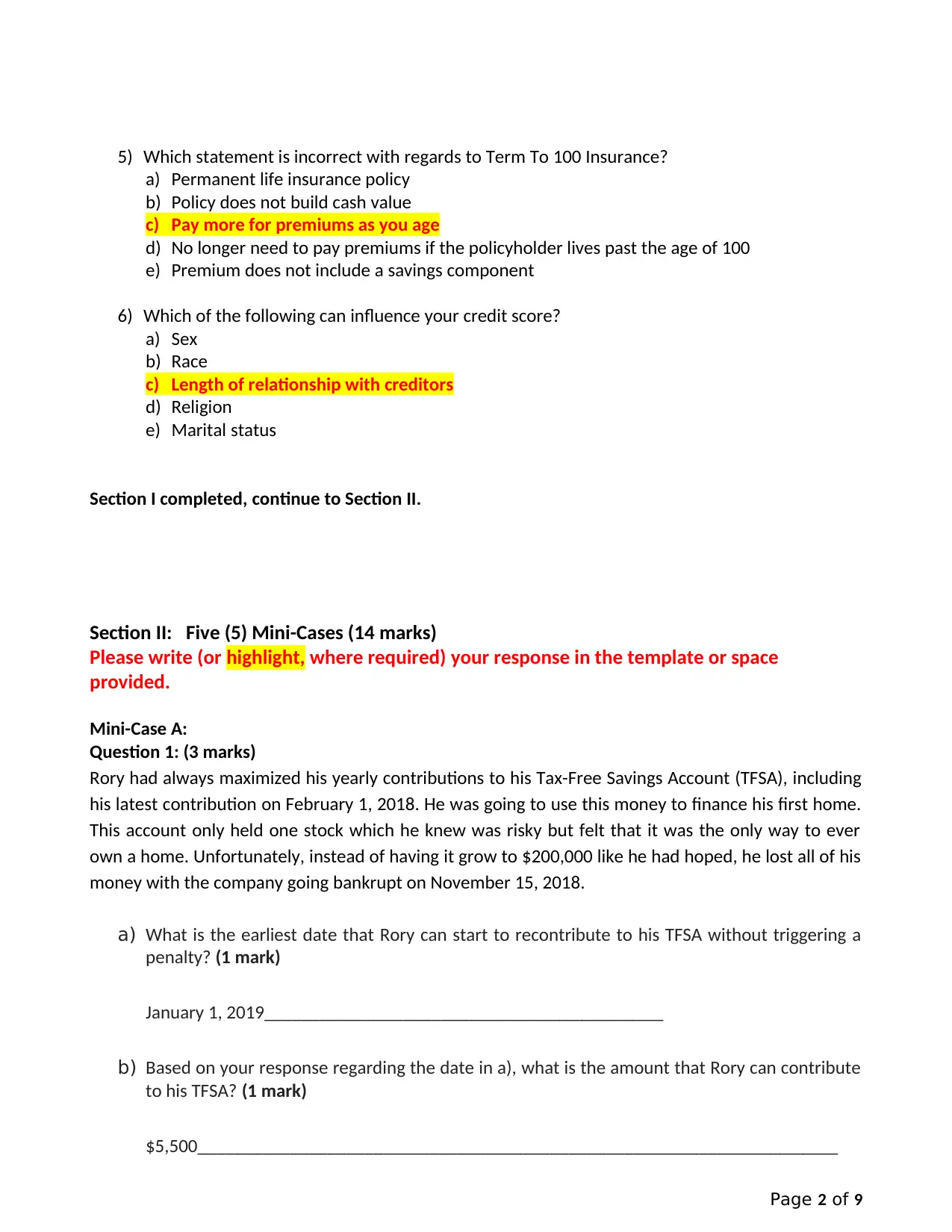
Section II: Five (5) Mini-Cases (14 marks)
Please write (or highlight, where required) your response in the template or space
provided.
Mini-Case A:
Question 1: (3 marks)
Rory had always maximized his yearly contributions to his Tax-Free Savings Account (TFSA), including
his latest contribution on February 1, 2018. He was going to use this money to finance his first home.
This account only held one stock which he knew was risky but felt that it was the only way to ever
own a home. Unfortunately, instead of having it grow to $200,000 like he had hoped, he lost all of his
money with the company going bankrupt on November 15, 2018.
a) What is the earliest date that Rory can start to recontribute to his TFSA without triggering a
penalty? (1 mark)
January 1, 2019___________________________________________
b) Based on your response regarding the date in a), what is the amount that Rory can contribute
to his TFSA? (1 mark)
$5,500_____________________________________________________________________
Page 2 of 9
5) Which statement is incorrect with regards to Term To 100 Insurance?
a) Permanent life insurance policy
b) Policy does not build cash value
c) Pay more for premiums as you age
d) No longer need to pay premiums if the policyholder lives past the age of 100
e) Premium does not include a savings component
6) Which of the following can influence your credit score?
a) Sex
b) Race
c) Length of relationship with creditors
d) Religion
e) Marital status
Section I completed, continue to Section II.
Please write (or highlight, where required) your response in the template or space
provided.
Mini-Case A:
Question 1: (3 marks)
Rory had always maximized his yearly contributions to his Tax-Free Savings Account (TFSA), including
his latest contribution on February 1, 2018. He was going to use this money to finance his first home.
This account only held one stock which he knew was risky but felt that it was the only way to ever
own a home. Unfortunately, instead of having it grow to $200,000 like he had hoped, he lost all of his
money with the company going bankrupt on November 15, 2018.
a) What is the earliest date that Rory can start to recontribute to his TFSA without triggering a
penalty? (1 mark)
January 1, 2019___________________________________________
b) Based on your response regarding the date in a), what is the amount that Rory can contribute
to his TFSA? (1 mark)
$5,500_____________________________________________________________________
Page 2 of 9
5) Which statement is incorrect with regards to Term To 100 Insurance?
a) Permanent life insurance policy
b) Policy does not build cash value
c) Pay more for premiums as you age
d) No longer need to pay premiums if the policyholder lives past the age of 100
e) Premium does not include a savings component
6) Which of the following can influence your credit score?
a) Sex
b) Race
c) Length of relationship with creditors
d) Religion
e) Marital status
Section I completed, continue to Section II.
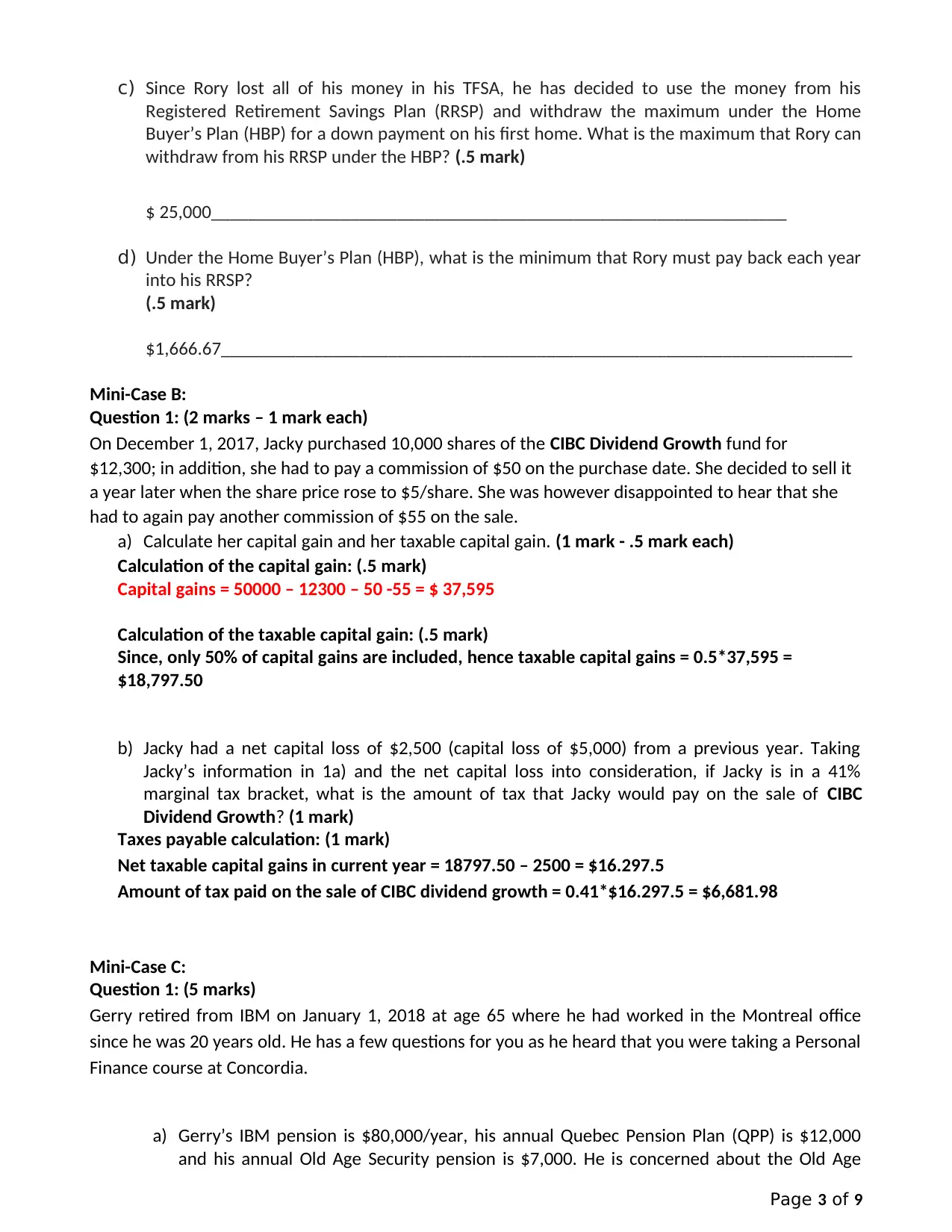
c) Since Rory lost all of his money in his TFSA, he has decided to use the money from his
Registered Retirement Savings Plan (RRSP) and withdraw the maximum under the Home
Buyer’s Plan (HBP) for a down payment on his first home. What is the maximum that Rory can
withdraw from his RRSP under the HBP? (.5 mark)
$ 25,000______________________________________________________________
d) Under the Home Buyer’s Plan (HBP), what is the minimum that Rory must pay back each year
into his RRSP?
(.5 mark)
$1,666.67____________________________________________________________________
Mini-Case B:
Question 1: (2 marks – 1 mark each)
On December 1, 2017, Jacky purchased 10,000 shares of the CIBC Dividend Growth fund for
$12,300; in addition, she had to pay a commission of $50 on the purchase date. She decided to sell it
a year later when the share price rose to $5/share. She was however disappointed to hear that she
had to again pay another commission of $55 on the sale.
a) Calculate her capital gain and her taxable capital gain. (1 mark - .5 mark each)
Calculation of the capital gain: (.5 mark)
Capital gains = 50000 – 12300 – 50 -55 = $ 37,595
Calculation of the taxable capital gain: (.5 mark)
Since, only 50% of capital gains are included, hence taxable capital gains = 0.5*37,595 =
$18,797.50
b) Jacky had a net capital loss of $2,500 (capital loss of $5,000) from a previous year. Taking
Jacky’s information in 1a) and the net capital loss into consideration, if Jacky is in a 41%
marginal tax bracket, what is the amount of tax that Jacky would pay on the sale of CIBC
Dividend Growth? (1 mark)
Taxes payable calculation: (1 mark)
Net taxable capital gains in current year = 18797.50 – 2500 = $16.297.5
Amount of tax paid on the sale of CIBC dividend growth = 0.41*$16.297.5 = $6,681.98
Mini-Case C:
Question 1: (5 marks)
Gerry retired from IBM on January 1, 2018 at age 65 where he had worked in the Montreal office
since he was 20 years old. He has a few questions for you as he heard that you were taking a Personal
Finance course at Concordia.
a) Gerry’s IBM pension is $80,000/year, his annual Quebec Pension Plan (QPP) is $12,000
and his annual Old Age Security pension is $7,000. He is concerned about the Old Age
Page 3 of 9
Registered Retirement Savings Plan (RRSP) and withdraw the maximum under the Home
Buyer’s Plan (HBP) for a down payment on his first home. What is the maximum that Rory can
withdraw from his RRSP under the HBP? (.5 mark)
$ 25,000______________________________________________________________
d) Under the Home Buyer’s Plan (HBP), what is the minimum that Rory must pay back each year
into his RRSP?
(.5 mark)
$1,666.67____________________________________________________________________
Mini-Case B:
Question 1: (2 marks – 1 mark each)
On December 1, 2017, Jacky purchased 10,000 shares of the CIBC Dividend Growth fund for
$12,300; in addition, she had to pay a commission of $50 on the purchase date. She decided to sell it
a year later when the share price rose to $5/share. She was however disappointed to hear that she
had to again pay another commission of $55 on the sale.
a) Calculate her capital gain and her taxable capital gain. (1 mark - .5 mark each)
Calculation of the capital gain: (.5 mark)
Capital gains = 50000 – 12300 – 50 -55 = $ 37,595
Calculation of the taxable capital gain: (.5 mark)
Since, only 50% of capital gains are included, hence taxable capital gains = 0.5*37,595 =
$18,797.50
b) Jacky had a net capital loss of $2,500 (capital loss of $5,000) from a previous year. Taking
Jacky’s information in 1a) and the net capital loss into consideration, if Jacky is in a 41%
marginal tax bracket, what is the amount of tax that Jacky would pay on the sale of CIBC
Dividend Growth? (1 mark)
Taxes payable calculation: (1 mark)
Net taxable capital gains in current year = 18797.50 – 2500 = $16.297.5
Amount of tax paid on the sale of CIBC dividend growth = 0.41*$16.297.5 = $6,681.98
Mini-Case C:
Question 1: (5 marks)
Gerry retired from IBM on January 1, 2018 at age 65 where he had worked in the Montreal office
since he was 20 years old. He has a few questions for you as he heard that you were taking a Personal
Finance course at Concordia.
a) Gerry’s IBM pension is $80,000/year, his annual Quebec Pension Plan (QPP) is $12,000
and his annual Old Age Security pension is $7,000. He is concerned about the Old Age
Page 3 of 9
You're viewing a preview
Unlock full access by subscribing today!
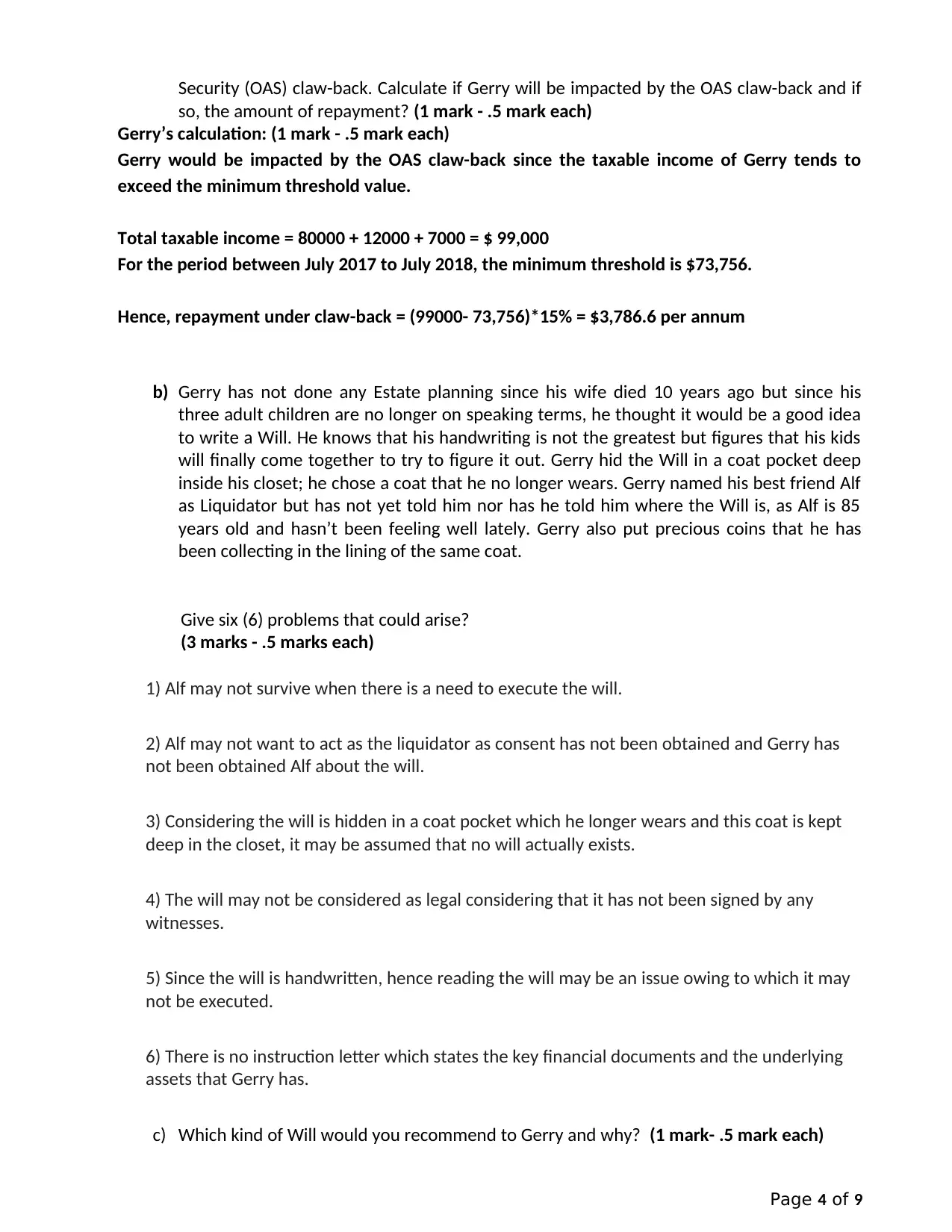
Security (OAS) claw-back. Calculate if Gerry will be impacted by the OAS claw-back and if
so, the amount of repayment? (1 mark - .5 mark each)
Gerry’s calculation: (1 mark - .5 mark each)
Gerry would be impacted by the OAS claw-back since the taxable income of Gerry tends to
exceed the minimum threshold value.
Total taxable income = 80000 + 12000 + 7000 = $ 99,000
For the period between July 2017 to July 2018, the minimum threshold is $73,756.
Hence, repayment under claw-back = (99000- 73,756)*15% = $3,786.6 per annum
b) Gerry has not done any Estate planning since his wife died 10 years ago but since his
three adult children are no longer on speaking terms, he thought it would be a good idea
to write a Will. He knows that his handwriting is not the greatest but figures that his kids
will finally come together to try to figure it out. Gerry hid the Will in a coat pocket deep
inside his closet; he chose a coat that he no longer wears. Gerry named his best friend Alf
as Liquidator but has not yet told him nor has he told him where the Will is, as Alf is 85
years old and hasn’t been feeling well lately. Gerry also put precious coins that he has
been collecting in the lining of the same coat.
Give six (6) problems that could arise?
(3 marks - .5 marks each)
1) Alf may not survive when there is a need to execute the will.
2) Alf may not want to act as the liquidator as consent has not been obtained and Gerry has
not been obtained Alf about the will.
3) Considering the will is hidden in a coat pocket which he longer wears and this coat is kept
deep in the closet, it may be assumed that no will actually exists.
4) The will may not be considered as legal considering that it has not been signed by any
witnesses.
5) Since the will is handwritten, hence reading the will may be an issue owing to which it may
not be executed.
6) There is no instruction letter which states the key financial documents and the underlying
assets that Gerry has.
c) Which kind of Will would you recommend to Gerry and why? (1 mark- .5 mark each)
Page 4 of 9
so, the amount of repayment? (1 mark - .5 mark each)
Gerry’s calculation: (1 mark - .5 mark each)
Gerry would be impacted by the OAS claw-back since the taxable income of Gerry tends to
exceed the minimum threshold value.
Total taxable income = 80000 + 12000 + 7000 = $ 99,000
For the period between July 2017 to July 2018, the minimum threshold is $73,756.
Hence, repayment under claw-back = (99000- 73,756)*15% = $3,786.6 per annum
b) Gerry has not done any Estate planning since his wife died 10 years ago but since his
three adult children are no longer on speaking terms, he thought it would be a good idea
to write a Will. He knows that his handwriting is not the greatest but figures that his kids
will finally come together to try to figure it out. Gerry hid the Will in a coat pocket deep
inside his closet; he chose a coat that he no longer wears. Gerry named his best friend Alf
as Liquidator but has not yet told him nor has he told him where the Will is, as Alf is 85
years old and hasn’t been feeling well lately. Gerry also put precious coins that he has
been collecting in the lining of the same coat.
Give six (6) problems that could arise?
(3 marks - .5 marks each)
1) Alf may not survive when there is a need to execute the will.
2) Alf may not want to act as the liquidator as consent has not been obtained and Gerry has
not been obtained Alf about the will.
3) Considering the will is hidden in a coat pocket which he longer wears and this coat is kept
deep in the closet, it may be assumed that no will actually exists.
4) The will may not be considered as legal considering that it has not been signed by any
witnesses.
5) Since the will is handwritten, hence reading the will may be an issue owing to which it may
not be executed.
6) There is no instruction letter which states the key financial documents and the underlying
assets that Gerry has.
c) Which kind of Will would you recommend to Gerry and why? (1 mark- .5 mark each)
Page 4 of 9
Paraphrase This Document
Need a fresh take? Get an instant paraphrase of this document with our AI Paraphraser
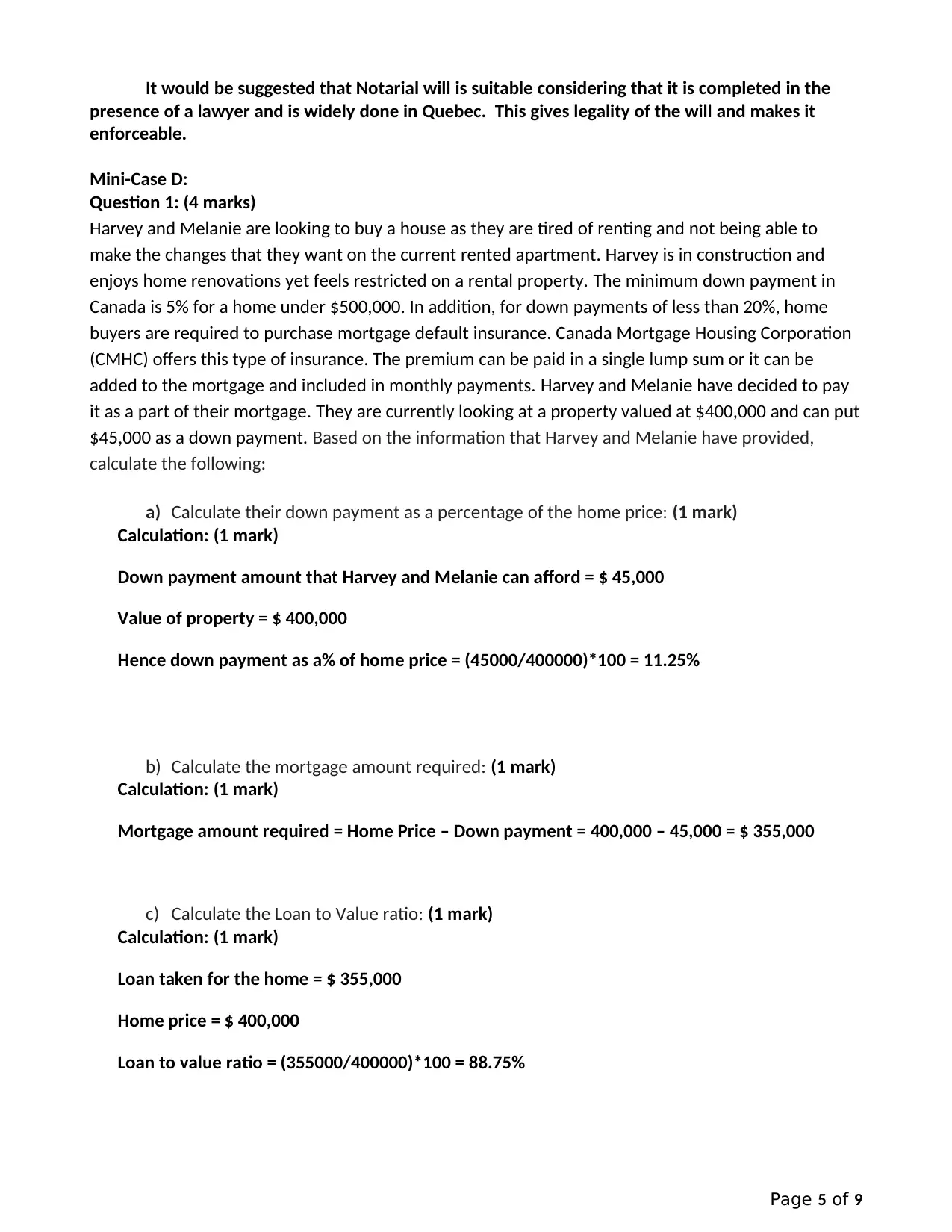
It would be suggested that Notarial will is suitable considering that it is completed in the
presence of a lawyer and is widely done in Quebec. This gives legality of the will and makes it
enforceable.
Mini-Case D:
Question 1: (4 marks)
Harvey and Melanie are looking to buy a house as they are tired of renting and not being able to
make the changes that they want on the current rented apartment. Harvey is in construction and
enjoys home renovations yet feels restricted on a rental property. The minimum down payment in
Canada is 5% for a home under $500,000. In addition, for down payments of less than 20%, home
buyers are required to purchase mortgage default insurance. Canada Mortgage Housing Corporation
(CMHC) offers this type of insurance. The premium can be paid in a single lump sum or it can be
added to the mortgage and included in monthly payments. Harvey and Melanie have decided to pay
it as a part of their mortgage. They are currently looking at a property valued at $400,000 and can put
$45,000 as a down payment. Based on the information that Harvey and Melanie have provided,
calculate the following:
a) Calculate their down payment as a percentage of the home price: (1 mark)
Calculation: (1 mark)
Down payment amount that Harvey and Melanie can afford = $ 45,000
Value of property = $ 400,000
Hence down payment as a% of home price = (45000/400000)*100 = 11.25%
b) Calculate the mortgage amount required: (1 mark)
Calculation: (1 mark)
Mortgage amount required = Home Price – Down payment = 400,000 – 45,000 = $ 355,000
c) Calculate the Loan to Value ratio: (1 mark)
Calculation: (1 mark)
Loan taken for the home = $ 355,000
Home price = $ 400,000
Loan to value ratio = (355000/400000)*100 = 88.75%
Page 5 of 9
presence of a lawyer and is widely done in Quebec. This gives legality of the will and makes it
enforceable.
Mini-Case D:
Question 1: (4 marks)
Harvey and Melanie are looking to buy a house as they are tired of renting and not being able to
make the changes that they want on the current rented apartment. Harvey is in construction and
enjoys home renovations yet feels restricted on a rental property. The minimum down payment in
Canada is 5% for a home under $500,000. In addition, for down payments of less than 20%, home
buyers are required to purchase mortgage default insurance. Canada Mortgage Housing Corporation
(CMHC) offers this type of insurance. The premium can be paid in a single lump sum or it can be
added to the mortgage and included in monthly payments. Harvey and Melanie have decided to pay
it as a part of their mortgage. They are currently looking at a property valued at $400,000 and can put
$45,000 as a down payment. Based on the information that Harvey and Melanie have provided,
calculate the following:
a) Calculate their down payment as a percentage of the home price: (1 mark)
Calculation: (1 mark)
Down payment amount that Harvey and Melanie can afford = $ 45,000
Value of property = $ 400,000
Hence down payment as a% of home price = (45000/400000)*100 = 11.25%
b) Calculate the mortgage amount required: (1 mark)
Calculation: (1 mark)
Mortgage amount required = Home Price – Down payment = 400,000 – 45,000 = $ 355,000
c) Calculate the Loan to Value ratio: (1 mark)
Calculation: (1 mark)
Loan taken for the home = $ 355,000
Home price = $ 400,000
Loan to value ratio = (355000/400000)*100 = 88.75%
Page 5 of 9
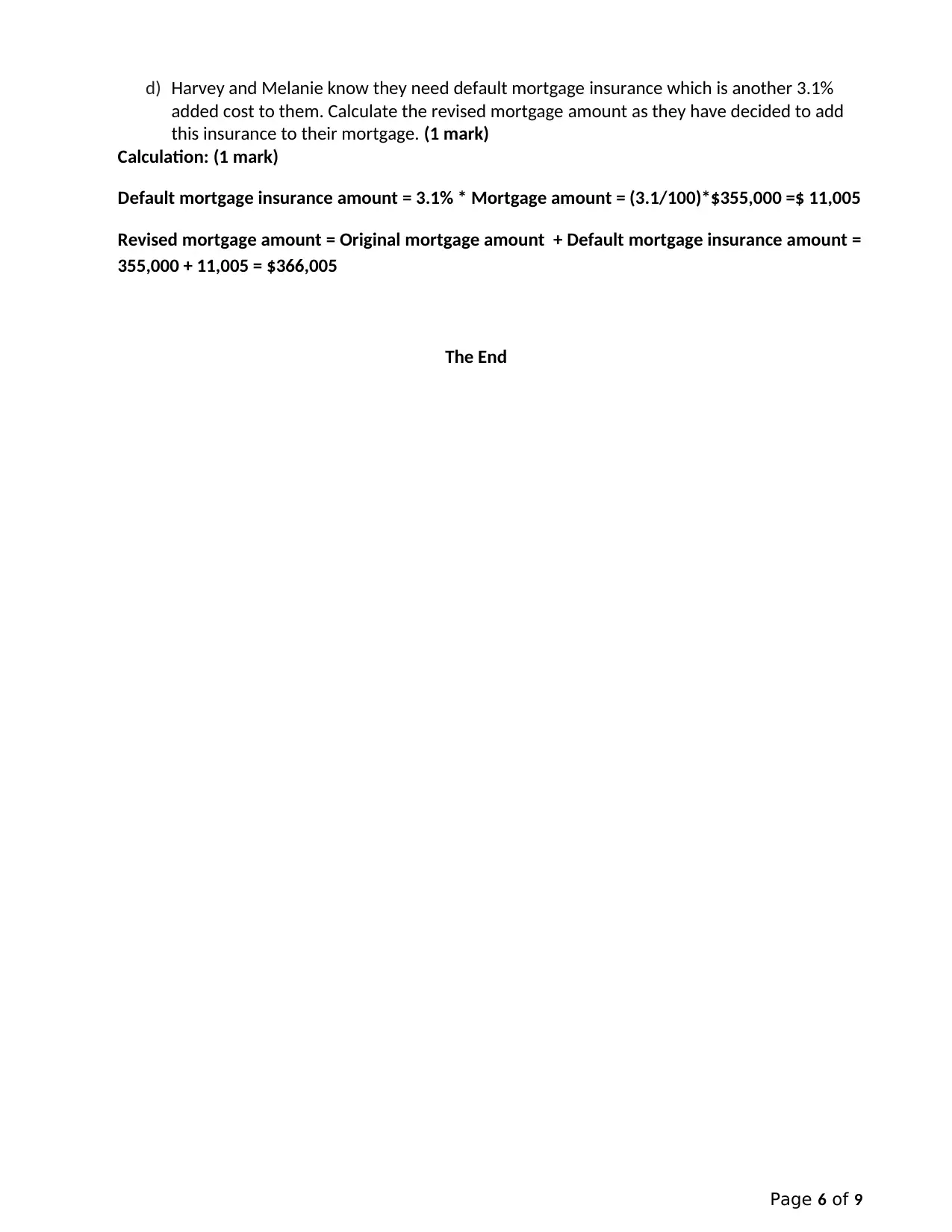
d) Harvey and Melanie know they need default mortgage insurance which is another 3.1%
added cost to them. Calculate the revised mortgage amount as they have decided to add
this insurance to their mortgage. (1 mark)
Calculation: (1 mark)
Default mortgage insurance amount = 3.1% * Mortgage amount = (3.1/100)*$355,000 =$ 11,005
Revised mortgage amount = Original mortgage amount + Default mortgage insurance amount =
355,000 + 11,005 = $366,005
The End
Page 6 of 9
added cost to them. Calculate the revised mortgage amount as they have decided to add
this insurance to their mortgage. (1 mark)
Calculation: (1 mark)
Default mortgage insurance amount = 3.1% * Mortgage amount = (3.1/100)*$355,000 =$ 11,005
Revised mortgage amount = Original mortgage amount + Default mortgage insurance amount =
355,000 + 11,005 = $366,005
The End
Page 6 of 9
You're viewing a preview
Unlock full access by subscribing today!
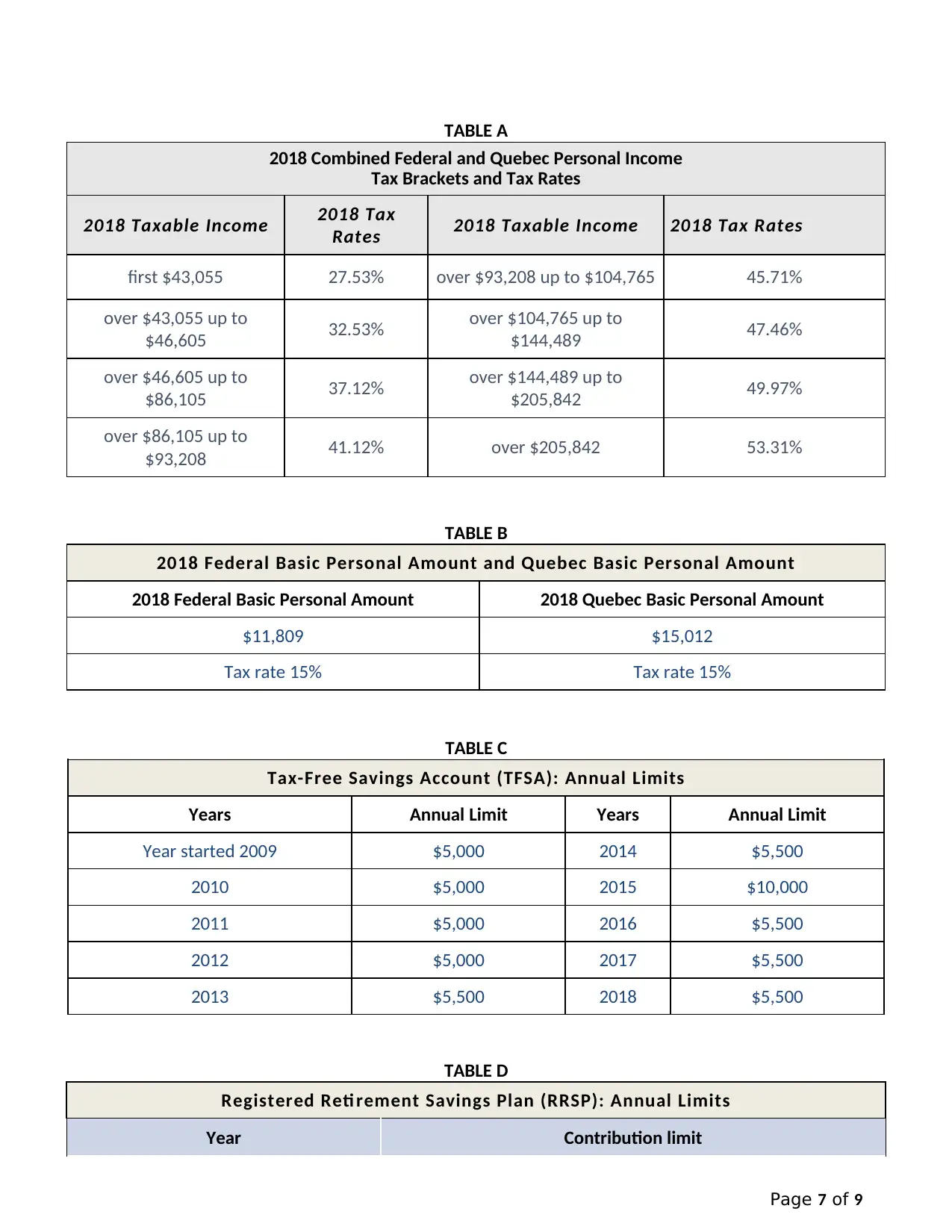
TABLE A
2018 Combined Federal and Quebec Personal Income
Tax Brackets and Tax Rates
2018 Taxable Income 2018 Tax
Rates 2018 Taxable Income 2018 Tax Rates
first $43,055 27.53% over $93,208 up to $104,765 45.71%
over $43,055 up to
$46,605 32.53% over $104,765 up to
$144,489 47.46%
over $46,605 up to
$86,105 37.12% over $144,489 up to
$205,842 49.97%
over $86,105 up to
$93,208 41.12% over $205,842 53.31%
TABLE B
2018 Federal Basic Personal Amount and Quebec Basic Personal Amount
2018 Federal Basic Personal Amount 2018 Quebec Basic Personal Amount
$11,809 $15,012
Tax rate 15% Tax rate 15%
TABLE C
Tax-Free Savings Account (TFSA): Annual Limits
Years Annual Limit Years Annual Limit
Year started 2009 $5,000 2014 $5,500
2010 $5,000 2015 $10,000
2011 $5,000 2016 $5,500
2012 $5,000 2017 $5,500
2013 $5,500 2018 $5,500
TABLE D
Registered Reti rement Savings Plan (RRSP): Annual Limits
Year Contribution limit
Page 7 of 9
2018 Combined Federal and Quebec Personal Income
Tax Brackets and Tax Rates
2018 Taxable Income 2018 Tax
Rates 2018 Taxable Income 2018 Tax Rates
first $43,055 27.53% over $93,208 up to $104,765 45.71%
over $43,055 up to
$46,605 32.53% over $104,765 up to
$144,489 47.46%
over $46,605 up to
$86,105 37.12% over $144,489 up to
$205,842 49.97%
over $86,105 up to
$93,208 41.12% over $205,842 53.31%
TABLE B
2018 Federal Basic Personal Amount and Quebec Basic Personal Amount
2018 Federal Basic Personal Amount 2018 Quebec Basic Personal Amount
$11,809 $15,012
Tax rate 15% Tax rate 15%
TABLE C
Tax-Free Savings Account (TFSA): Annual Limits
Years Annual Limit Years Annual Limit
Year started 2009 $5,000 2014 $5,500
2010 $5,000 2015 $10,000
2011 $5,000 2016 $5,500
2012 $5,000 2017 $5,500
2013 $5,500 2018 $5,500
TABLE D
Registered Reti rement Savings Plan (RRSP): Annual Limits
Year Contribution limit
Page 7 of 9
Paraphrase This Document
Need a fresh take? Get an instant paraphrase of this document with our AI Paraphraser
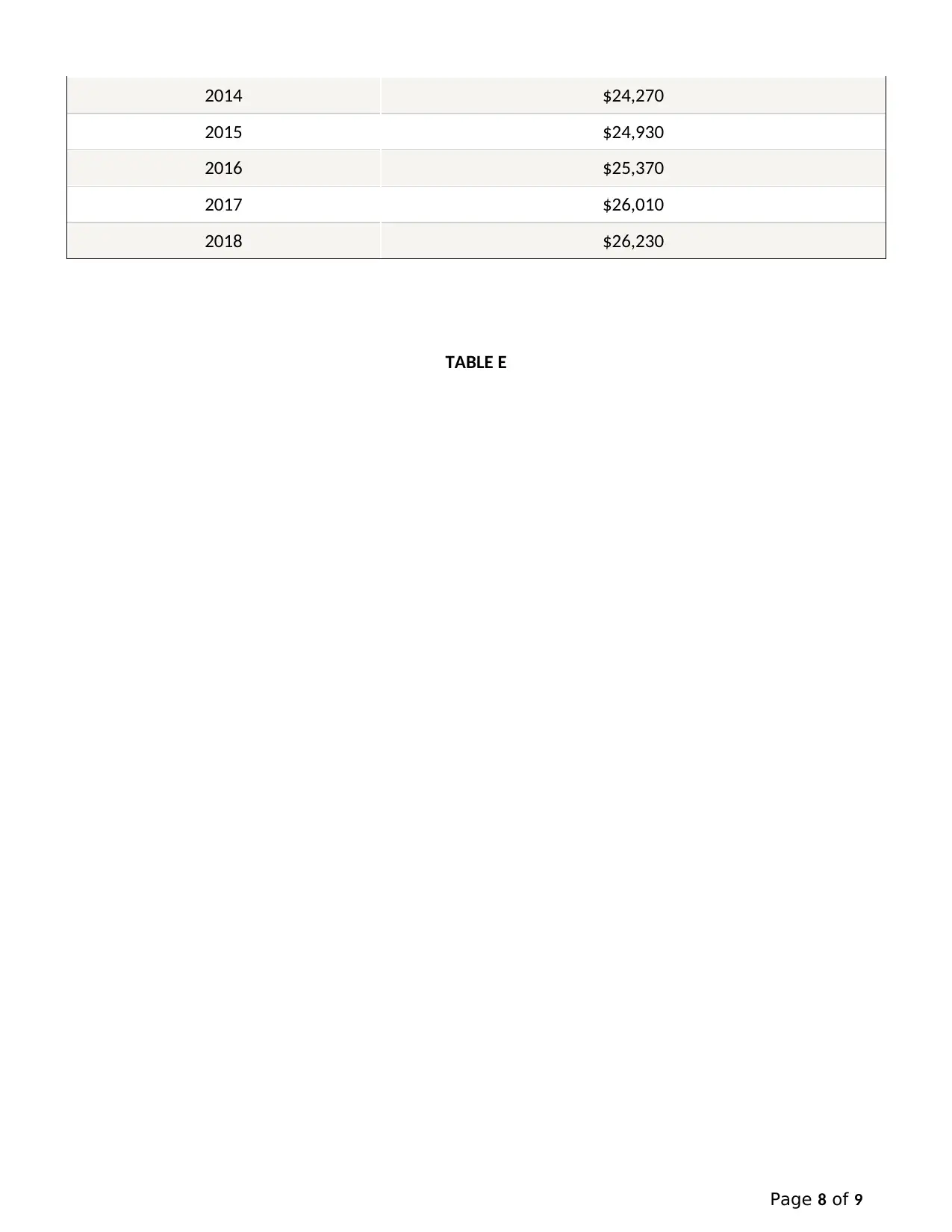
2014 $24,270
2015 $24,930
2016 $25,370
2017 $26,010
2018 $26,230
TABLE E
Page 8 of 9
2015 $24,930
2016 $25,370
2017 $26,010
2018 $26,230
TABLE E
Page 8 of 9
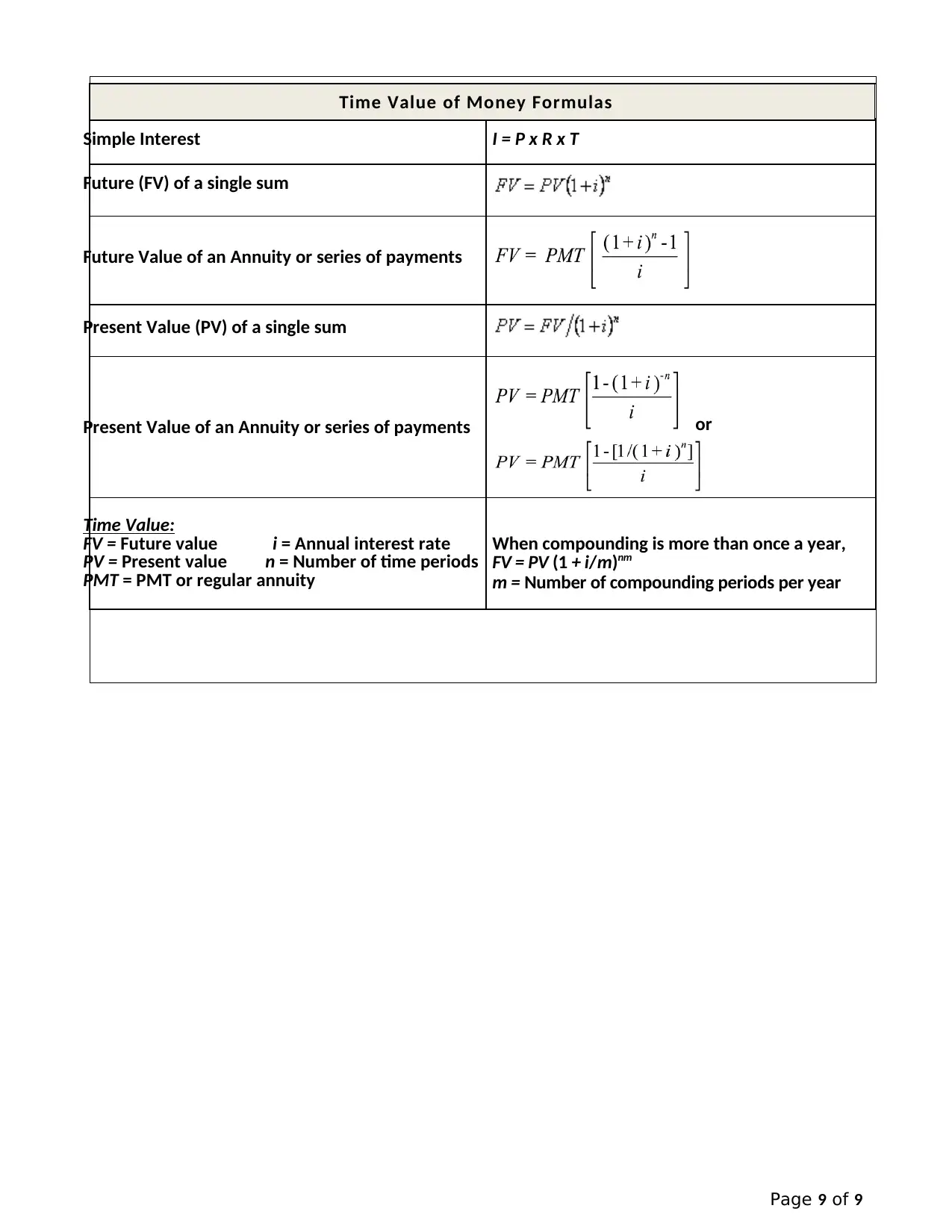
Page 9 of 9
Time Value of Money Formulas
Simple Interest I = P x R x T
Future (FV) of a single sum
Future Value of an Annuity or series of payments
Present Value (PV) of a single sum
Present Value of an Annuity or series of payments or
Time Value:
FV = Future value i = Annual interest rate
PV = Present value n = Number of time periods
PMT = PMT or regular annuity
When compounding is more than once a year,
FV = PV (1 + i/m)nm
m = Number of compounding periods per year
Time Value of Money Formulas
Simple Interest I = P x R x T
Future (FV) of a single sum
Future Value of an Annuity or series of payments
Present Value (PV) of a single sum
Present Value of an Annuity or series of payments or
Time Value:
FV = Future value i = Annual interest rate
PV = Present value n = Number of time periods
PMT = PMT or regular annuity
When compounding is more than once a year,
FV = PV (1 + i/m)nm
m = Number of compounding periods per year
You're viewing a preview
Unlock full access by subscribing today!
1 out of 9
Your All-in-One AI-Powered Toolkit for Academic Success.
+13062052269
info@desklib.com
Available 24*7 on WhatsApp / Email
![[object Object]](/_next/static/media/star-bottom.7253800d.svg)
Unlock your academic potential
© 2024 | Zucol Services PVT LTD | All rights reserved.

